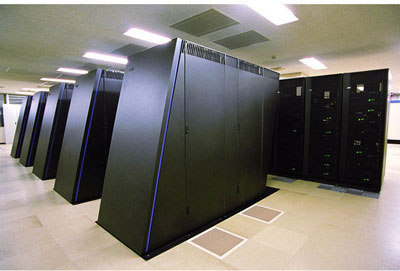| Posted: April 10, 2009 |
Supercomputers allow researchers to calculate symmetry violations in the strong interaction that holds atoms together |
|
(Nanowerk News) An international research team has reconciled two theories that explain the properties of the pion. The work is important because this subatomic particle plays a key role in the strong interaction—the fundamental force that holds atomic nuclei together.
|
|
The pion consists of a quark and an anti-quark, meaning it is classified as a hadron alongside protons and neutrons—but it has very different properties.
|
|
“One puzzle was that the pion is much lighter than other hadrons,” says scientist Sinya Aoki, based at the University of Tsukuba and the RIKEN BNL Center in New York.
|
|
The unexpectedly light pion mass was first explained by Yoichiro Nambu, who received the Nobel Prize for Physics in 2008. He realized that the strong interaction usually obeys a rule called ‘chiral symmetry’, but in a vacuum this rule can be broken.
|
|
“A quark has spin, or self-rotation, which can be in a left-handed or right-handed direction,” Aoki explains. “The chiral symmetry means that left-handed quarks and right-handed quarks never mix with each other. If this chiral symmetry is spontaneously broken, a pion appears to be massless. This, however, is not true if the quarks have mass.”
|
|
In fact, pions have a tiny mass due to the small but non-zero quark mass, irrespective of the large energy scale of the strong interaction.
|
|
Effects of quark mass in the presence of spontaneous chiral symmetry breaking have been illustrated using a tool called chiral perturbation theory. However it is important to show that the symmetry breaking can occur in the fundamental theory of the strong interaction, called quantum chromodynamics (QCD), which governs the behavior of quarks and gluons.
|
|
Until now it has been difficult for QCD to verify the small pion mass owing to problems such as ‘sea quarks’—virtual quark-antiquark pairs that pop in and out of existence in the gluon field.
|
 |
| The supercomputer at the High Energy Accelerator Research Organization (KEK) in Tsukuba that was used to verify the small mass of the pion within the fundamental theory of quantum chromodynamics.
|
|
In their latest work (Convergence of the Chiral Expansion in Two-Flavor Lattice QCD), Aoki and co-workers used powerful supercomputers (Fig. 1) at the High Energy Accelerator Research Organization (KEK) in Tsukuba to run QCD numerically on a lattice. They calculated exactly how the mass and decay properties of a pion depend on the quark mass.
|
|
They have shown for the first time that QCD provides the same results as chiral perturbation theory, if one assumes a small enough quark mass. Aoki is delighted with the success.
|
|
“Our results not only show that the lattice QCD and the chiral perturbation theory agree, but also prove that Nambu's chiral symmetry breaking indeed occurs in QCD.”
|

